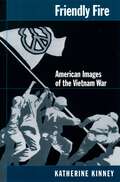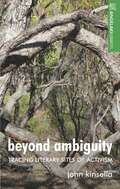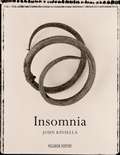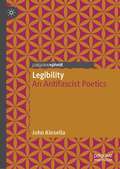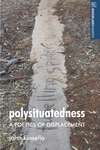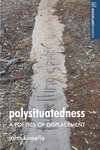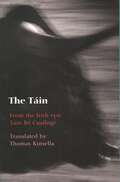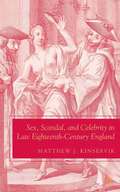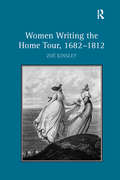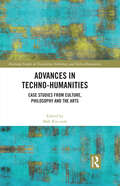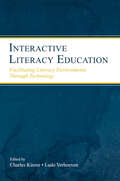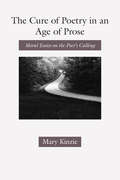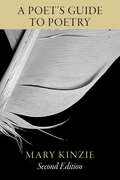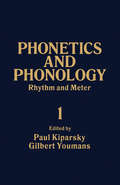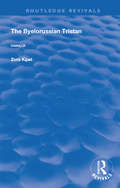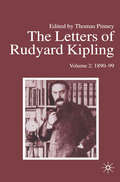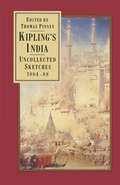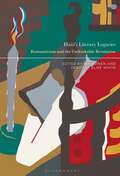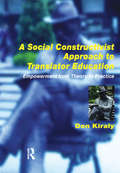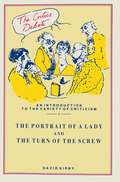- Table View
- List View
Friendly Fire: American Images of the Vietnam War
by Katherine KinneyHundreds of memoirs, novels, plays, and movies have been devoted to the American war in Vietnam. In spite of the great variety of media, political perspectives and the degrees of seriousness with which the war has been treated, Katherine Kinney argues that the vast majority of these works share a single story: that of Americans killing Americans in Vietnam. Friendly Fire, in this instance, refers not merely to a tragic error of war, it also refers to America's war with itself during the Vietnam years. Starting from this point, this book considers the concept of "friendly fire" from multiple vantage points, and portrays the Vietnam age as a crucible where America's cohesive image of itself is shattered--pitting soldiers against superiors, doves against hawks, feminism against patriarchy, racial fear against racial tolerance. Through the use of extensive evidence from the film and popular fiction of Vietnam (e.g. Kovic's Born on the Fourth of July, Didion's Democracy, O'Brien's Going After Cacciato, Rabe's Sticks and Bones and Streamers), Kinney draws a powerful picture of a nation politically, culturally, and socially divided, and a war that has been memorialized as a contested site of art, media, politics, and ideology.
Beyond ambiguity: Tracing literary sites of activism (Angelaki Humanities)
by John KinsellaThis volume completes John Kinsella’s trilogy of critical activist poetics, begun two decades ago. It challenges familiar topoi and normatives of poetic activity as it pertains to environmental, humanitarian and textual activism in ‘the world-at-large’: it shows how ambiguity can be a generative force when it works from a basis of non-ambiguity of purpose. The book shows how there is a clear unambiguous position to have regarding issues of justice, but that from that confirmed point ambiguity can be an intense and useful activist tool. The book is an essential resource for those wishing to study Kinsella, and for those with an interest in twentieth and twenty-first-century poetry and poetics, and it will stand as an inspiring proclamation of the author's faith in the transformative power of poetry and literary activity as a force for good in the world.
Beyond ambiguity: Tracing literary sites of activism (Angelaki Humanities)
by John KinsellaThis volume completes John Kinsella’s trilogy of critical activist poetics, begun two decades ago. It challenges familiar topoi and normatives of poetic activity as it pertains to environmental, humanitarian and textual activism in ‘the world-at-large’: it shows how ambiguity can be a generative force when it works from a basis of non-ambiguity of purpose. The book shows how there is a clear unambiguous position to have regarding issues of justice, but that from that confirmed point ambiguity can be an intense and useful activist tool. The book is an essential resource for those wishing to study Kinsella, and for those with an interest in twentieth and twenty-first-century poetry and poetics, and it will stand as an inspiring proclamation of the author's faith in the transformative power of poetry and literary activity as a force for good in the world.
Insomnia
by John KinsellaThe Australian poet John Kinsella’s vivid and urgent new collection addresses the crisis of being that currently afflicts us: Kinsella addresses a situation where the creations of the human imagination, the very means by which we extend our empathies into the world – art, music and philosophy – suddenly find themselves in a world that not only denies their importance, but can sometimes seem to have no use for them at all. In an attempt to find a still point from which we might reconfigure our perspective and address the paradoxes of our contemporary experience, Kinsella has written poems of self-accusation and angry protest, meditations on the nature of loss and trauma, and full-throated celebrations of the natural world. Ranging from Jam Tree Gully, Western Australia to the coast of West Cork, Ireland, haunted by historical and literary figures from Dante to Emily Brontë (whom Kinsella has obsessed over since he was a child, and who intervenes in the poet’s attempts to come to grips with ideas of colonization and identity), Insomnia may be Kinsella’s most various and powerful collection to date.
Legibility: An Antifascist Poetics (Modern and Contemporary Poetry and Poetics)
by John KinsellaThis Pivot book provides a wide-ranging and diverse commentary on issues of legibility (and illegibility) around poetry, antifascist pacifist activism, environmentalism and the language of protest. A timely meditation from poet John Kinsella, the book focuses on participation in protest, demonstration and intervention on behalf of human rights activism, and writing and acting peacefully but persistently against tyranny. The book also examines how we make records and what we do with them, how we might use poetry to act or enact and/or to discuss such necessities and events. A book about community, human and animal rights and the way poetry can be used as a peaceful and decisive means of intervention in moment of public social and environmental crisis. Ultimately, it is a poetics against fascism with a focus on the well-being of the biosphere and all it contains.
Polysituatedness: A poetics of displacement (PDF)
by John KinsellaJohn Kinsella is one of the pre-eminent poets writing today; Polysituatedness provides a sequel to his critical work Disclosed Poetics. If offers an approach to creating poems and literary texts constituted by multiple places, considering the relationships that occur between place, individual and the natural environment.
Polysituatedness: A poetics of displacement (Angelaki Humanities Ser.)
by John KinsellaJohn Kinsella is one of the pre-eminent poets writing today; Polysituatedness provides a sequel to his critical work Disclosed Poetics. If offers an approach to creating poems and literary texts constituted by multiple places, considering the relationships that occur between place, individual and the natural environment.
The Táin: From the Irish epic Táin Bó Cuailnge
by Thomas KinsellaThe Táin Bó Cuailnge, centre-piece of the eighth-century Ulster cycle of heroic tales, is Ireland's greatest epic. It tells the story of a great cattle-raid, the invasion of Ulster by the armies of Medb and Ailill, queen and king of Connacht, and their allies, seeking to carry off the great Brown Bull of Cuailnge. The hero of the tale is Cuchulainn, the Hound of Ulster, who resists the invaders single-handed while Ulster's warriors lie sick. Thomas Kinsella presents a complete and living version of the story. His translation is based on the partial texts in two medieval manuscripts, with elements from other versions, and adds a group of related stories which prepare for the action of the Táin. Illustrated with brush drawings by Louis le Brocquy, this edition provides a combination of medieval epic and modern art.
Sex, Scandal, and Celebrity in Late Eighteenth-Century England (The New Middle Ages)
by M. KinservikThis book tells the story of the bitter feud between the Duchess of Kingston and the actor, Samuel Foote, which resulted in a pair of scandalous trials in London in the revolutionary year of 1776. Set against the backdrop of the American Revolution, the duchess's state trial for bigamy and Foote's criminal trial for attempted sodomy engrossed the attention of Londoners, including George III, Parliament, and the nobility. Sex, Scandal, and Celebrity offers specialists and general readers a meticulously researched and dramatic narrative that relates the fortunes and misfortunes of its protagonists and exposes the social and legal hypocrisies about love, sex, and marriage in the age of George III.
Women Writing the Home Tour, 1682–1812
by Zoë KinsleyBetween the late seventeenth and the early nineteenth century, the possibilities for travelling within Britain became increasingly various owing to improved transport systems and the popularization of numerous tourist spots. Women Writing the Home Tour, 1682-1812 examines women's participation in that burgeoning touristic tradition, considering the ways in which the changing face of British travel and its writing can be traced through the accounts produced by the women who journeyed England, Scotland, and Wales during this important period. This book explores female-authored home tour travel narratives in print, as well as manuscript works that have hitherto been neglected in criticism. Discussing texts produced by authors including Celia Fiennes, Ann Radcliffe and Dorothy Wordsworth alongside the works of lesser-known travellers such as Mary Morgan and Dorothy Richardson, Kinsley considers the construction, and also the destabilization, of gender, class, and national identity through chapters that emphasize the diversity and complexity of this rich body of writings.
Women Writing the Home Tour, 1682–1812
by Zoë KinsleyBetween the late seventeenth and the early nineteenth century, the possibilities for travelling within Britain became increasingly various owing to improved transport systems and the popularization of numerous tourist spots. Women Writing the Home Tour, 1682-1812 examines women's participation in that burgeoning touristic tradition, considering the ways in which the changing face of British travel and its writing can be traced through the accounts produced by the women who journeyed England, Scotland, and Wales during this important period. This book explores female-authored home tour travel narratives in print, as well as manuscript works that have hitherto been neglected in criticism. Discussing texts produced by authors including Celia Fiennes, Ann Radcliffe and Dorothy Wordsworth alongside the works of lesser-known travellers such as Mary Morgan and Dorothy Richardson, Kinsley considers the construction, and also the destabilization, of gender, class, and national identity through chapters that emphasize the diversity and complexity of this rich body of writings.
Advances in Techno-Humanities: Case Studies from Culture, Philosophy and the Arts (Routledge Studies in Translation Technology and Techno-Humanities)
by Mak Kin-WahThis book is a pioneering attempt to explore the relationships between technology and the humanities through case studies and specific contexts in the areas of language, theatre, literature, translation, philosophy, music, home designations, learning environment, and artificial intelligence. Written by scholars and specialists across various fields, the chapters explore the emerging field of techno-humanities. This book examines the development of language and society by means of Big Data, how technology is integrated into the theatres of Hong Kong and the ensuing results of such integration. The authors also highlight how technology is able to analyse, understand, and visualise literary works and to bring drastic changes to translation in the past seven decades. Long-standing philosophical issues are re-examined, linkages between technology and theoretical concepts are illuminated, and the emotional aspects of computational applications are investigated. This book also delves into insightful case studies such as providing suggestions to train novice translators through corpus-assisted translation teaching, analysing patterns of housing names, and discovering a new online method to acknowledge acquisition through authentic learning experiences. Overall, this book serves as a point of departure for us to go deeper into the role of technology in transforming the humanities in this digital age. This is a useful read for students and scholars interested in learning more about the cross section between humanities and technology.
Interactive Literacy Education: Facilitating Literacy Environments Through Technology
by Charles Kinzer Ludo VerhoevenInteractive Literacy Education combines the latest research and theory related to technology-based instructional design for children’s literacy development. It shows how technology can be used to build literacy learning environments that are compatible with students’ cognitive and social processes. Topics addressed throughout this enlightening work include:*technology environments and applications that preservice teachers can use with young children;*detailed information regarding the development and implementation of specific technological programs; and*various technologies, from interactive reading and spelling programs to speech recognition to multimedia, that teachers can use to enhance their literacy learning environments. Interactive Literacy Education is intended for graduate courses in methods of literacy instruction; educational technology; curriculum/curriculum design; general preservice education; special education; and applied psychology/cognitive studies. It is also appropriate for use as a supplement in undergraduate courses in methods of literacy instruction and educational technology.
The Cure of Poetry in an Age of Prose: Moral Essays on the Poet's Calling
by Mary KinzieThe role of the poet, Mary Kinzie writes, is to engage the most profound subjects with the utmost in expressive clarity. The role of the critic is to follow the poet, word for word, into the arena where the creative struggle occurs. How this mutual purpose is served, ideally and practically, is the subject of this bracingly polemical collection of essays. A distinguished poet and critic, Kinzie assesses poetry's situation during the past twenty-five years. Ours, she contends, is literally a prosaic age, not only in the popularity of prose genres but in the resultant compromises with truth and elegance in literature. In essays on "the rhapsodic fallacy," confessionalism, and the romance of perceptual response, Kinzie diagnoses some of the trends that diminish the poet's flexibility. Conversely, she also considers individual poets—Randall Jarrell, Elizabeth Bishop, Howard Nemerov, Seamus Heaney, and John Ashbery—who have found ingenious ways of averting the risks of prosaism and preserving the special character of poetry. Focusing on poet Louise Bogan and novelist J. M. Coetzee, Kinzie identifies a crucial and curative overlap between the practices of great prose-writing and great poetry. In conclusion, she suggests a new approach for teaching writers of poetry and fiction. Forcefully argued, these essays will be widely read and debated among critics and poets alike.
A Poet's Guide to Poetry, Second Edition (Chicago Guides to Writing, Editing, and Publishing)
by Mary KinzieIn A Poet’s Guide to Poetry, Mary Kinzie brings her decades of expertise as poet, critic, and director of the creative writing program at Northwestern University to bear in a comprehensive reference work for any writer wishing to better understand poetry. Detailing the formal concepts of poetry and methods of poetic analysis, she shows how the craft of writing can guide the art of reading poems. Using examples from the major traditions of lyric and meditative poetry in English from the medieval period to the present, Kinzie considers the sounds and rhythms of poetry along with the ideas and thought-units within poems. Kinzie also shares her own successful classroom tactics that encourage readers to approach a poem as if it were provisional. The three parts of A Poet’s Guide to Poetry lead the reader through a carefully planned introduction to the ways we understand poetry. The first section provides careful, step-by-step instruction to familiarize students with the formal elements of poems, from the most obvious feature through the most subtle. The second part carefully examines meter and rhythm, as well as providing a theoretical and practical overview of free verse. The final section offers helpful chapters on writing in form. Rounding out the volume are writing exercises for beginning and advanced writers, a dictionary of poetic terms, and a bibliography of further reading. For this new edition, Kinzie has carefully reworked the introductory material and first chapter, as well as amended the annotated bibliography to include the most recent works of criticism. The updated guide also contains revised exercises and adjustments throughout the text to make the work as lucid and accessible as possible.
Rhythm and Meter: Phonetics and Phonology, Vol. 1
by Paul Kiparsky Gilbert YoumansPhonetics and Phonology: Volume 1, Rhythm and Meter compiles original articles by 12 linguists and literary critics who have made important contributions to current theories of phonology, verse meter, and music.This book mainly focuses on English poetry—on the meters of Shakespeare, Milton, Blake, Longfellow, Hopkins, Auden, and other Renaissance dramatists. Poetry in other languages that include Greek, Arabic, Hebrew, Russian, and German are also examined. This publication emphasizes metrical theory, formulating and illustrating metrical principles within the tradition of generative metrics and competing traditions. The relationships between rhythm in language and music are likewise analyzed.This volume is useful to linguists, literary critics, and specialists conducting work on rhythm and meter.
The Byelorussian Tristan (Routledge Revivals)
by Zora KipelOriginally published in 1988, this book is a complete translation of The Byelorussian Tristan, alongside textual notes.
The Letters of Rudyard Kipling: Volume 2: 1890-99
by R. KiplingKipling's letters, never before collected and edited and largely unpublished, are now presented in an annotated edition based on the more than 6,000 letters preserved in public and private collections all over the world. Planned in an edition of four volumes, the Letters reveal Kipling with a fullness and immediacy of detail unmatched by any other source. The first two volumes present the first half of Kipling's life, down to the end of the nineteenth century. They show the remarkable transformation of the young schoolboy into the seasoned Indian journalist, and the even more remarkable transformation of the Indian journalist into the famous writer, the most dazzling literary success of the 1890s. Kipling's hard years of apprenticeship, his restless travels and eager encounters with cities and men, his triumphant struggles in the literary wars, are all vividly set forth. The Letters also take Kipling through his marriage and the births of his children, through the mingled happiness and distress of his American years, to the tragedy of his daughter's death at the very highest moment of his literary fame.
Haiti’s Literary Legacies: Romanticism and the Unthinkable Revolution
by Kir Kuiken and Deborah Elise WhiteThe essays gathered in Haiti's Literary Legacies unpack the theoretical, historical, and political resonance of the Haitian revolution across a multiplicity of European and American Romanticisms, and include discussion of Haitian, British, French, German, and U.S. American traditions. Often referred to as the only successful slave revolt in history, the revolution that forged Haiti at once fulfilled, challenged, and ultimately surpassed Enlightenment conceptions of freedom and universality in ways that became crucial to transnational Romanticism, yet scholars and historians of Romanticism are only beginning to take the measure of its impact. This collection works at the intersection of Romantic and Caribbean studies to move that project forward, showing the myriad ways that literatures of the Romantic period respond to-and are transformed by-the Revolution in Haiti. Demonstrating the Revolution's centrality to romantic writing, Haiti's Literary Legacies urges an enlarged understanding of Romanticism and of its implications for the political, historical, and ecological genealogies of the present.
Haiti’s Literary Legacies: Romanticism and the Unthinkable Revolution
by Kir Kuiken and Deborah Elise WhiteThe essays gathered in Haiti's Literary Legacies unpack the theoretical, historical, and political resonance of the Haitian revolution across a multiplicity of European and American Romanticisms, and include discussion of Haitian, British, French, German, and U.S. American traditions. Often referred to as the only successful slave revolt in history, the revolution that forged Haiti at once fulfilled, challenged, and ultimately surpassed Enlightenment conceptions of freedom and universality in ways that became crucial to transnational Romanticism, yet scholars and historians of Romanticism are only beginning to take the measure of its impact. This collection works at the intersection of Romantic and Caribbean studies to move that project forward, showing the myriad ways that literatures of the Romantic period respond to-and are transformed by-the Revolution in Haiti. Demonstrating the Revolution's centrality to romantic writing, Haiti's Literary Legacies urges an enlarged understanding of Romanticism and of its implications for the political, historical, and ecological genealogies of the present.
A Social Constructivist Approach to Translator Education: Empowerment from Theory to Practice
by Donald KiralyThis is a book about the teaching and particularly the acquisition of translation-related skills and knowledge. Well grounded in theory, the book also provides numerous examples drawn from the author's extensive classroom experience in translator education and foreign language teaching. Kiraly uses a number of classroom case studies to illustrate his method, including: introductory courses in translation studies, project-based translation practice courses, translation studies seminars, as well as naturalistic foreign language learning classes for student translators. The book is primarily geared toward translator educators and programme administrators, as well as students of translation, and will also be of interest to foreign language teachers who incorporate translation into their teaching, to translation scholars, and to others involved in the world of translation.
A Social Constructivist Approach to Translator Education: Empowerment from Theory to Practice
by Donald KiralyThis is a book about the teaching and particularly the acquisition of translation-related skills and knowledge. Well grounded in theory, the book also provides numerous examples drawn from the author's extensive classroom experience in translator education and foreign language teaching. Kiraly uses a number of classroom case studies to illustrate his method, including: introductory courses in translation studies, project-based translation practice courses, translation studies seminars, as well as naturalistic foreign language learning classes for student translators. The book is primarily geared toward translator educators and programme administrators, as well as students of translation, and will also be of interest to foreign language teachers who incorporate translation into their teaching, to translation scholars, and to others involved in the world of translation.
The Portrait of a Lady/The Turn of the Screw (The Critics Debate)
by David KirbyIn this study, the author summarizes the reactions of the leading schools of criticism to these works and offers his own consideration of them, arguing that the novels are read most beneficially within the context of genre studies and that each is a melodrama.
